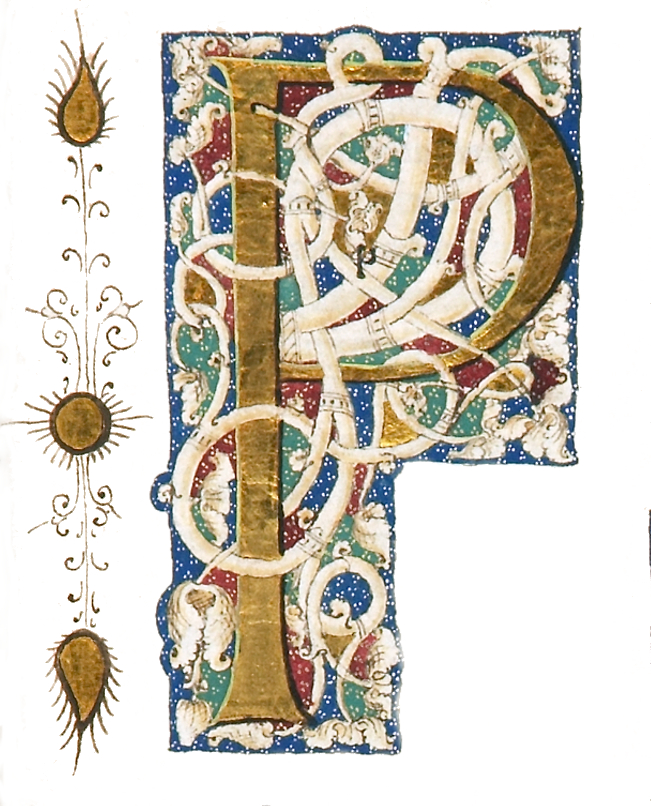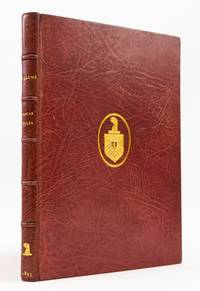1909 · London
by (RICCARDI PRESS). FLINT, WILLIAM RUSSELL, Illustrator
London: [Printed at the Riccardi Press for] Philip Lee Warner, Publisher to the Medici Society, 1909. No. 61 OF 500 COPIES. 260 x 194 mm. (10 1/4 x 7 5/8"). 6 p.l., 16, [1] pp.
Pleasing olive brown crushed morocco by Bumpus (stamp-signed on front turn-in), covers framed with three sets of triple fillets, raised bands, spine compartments similarly framed, gilt titling and turn-ins, all edges gilt. Vignette on title page and colophon, both in blue, and 10 fine color plates by Russell Flint, mounted on stiff paper, each of the plates accompanied by a tissue guard and an additional captioned paper guard. Tomkinson, p. 148. ◆Spine faded to a soft hazel brown (as usual with green), boards with just a hint of the same fading, very slight rubbing to a small portion of the joints, usual offsetting from turn-ins to endleaves, one tissue guard with one-inch strip torn at head edge, but still a very appealing copy, the attractive binding lustrous and with no significant wear, and the interior clean and fresh.
Containing, in Houfe's words, "brilliant" figures that are "finely modeled" and that show "elements of a Burne-Jones influence by way of Byam Shaw," this is the first of a series of luxury editions produced by Sir William Russell Flint (1880-1969) for the Riccardi Press of the Medici Society between 1905-24. As Tomkinson relates, the Riccardi Press "was adopted in 1909 by the Medici Society at 7 Grafton Street, London; the books [were] printed at the Chiswick Press (under the supervision of Charles T. Jacobi until his retirement in 1922) and published by Philip Lee Warner, who was Publisher to the Medici Society until his death in 1925 . . . . The aim of the Press has been to produce finely printed books at reasonable prices and for sale through the ordinary channels of trade. . . . All editions are strictly limited, and the type is distributed after the edition has been printed." Although Riccardi Press books do not rank with Kelmscotts or Ashendenes, those with plates after Flint have considerable appeal, and as an inaugural publication, the present volume represents a significant achievement. Although simple in design, our binding reflects the typically well-executed and generally undervalued work produced with the Bumpus name for a substantial period, beginning in the latter part of the 19th century. Packer says that the Bumpus bindings emanated from the bookselling firm of John and Edward Bumpus, which was founded in 1780, and the Bumpus name still held an honored place among London binderies well into the 20th century.. (Inventory #: ST12288)
Pleasing olive brown crushed morocco by Bumpus (stamp-signed on front turn-in), covers framed with three sets of triple fillets, raised bands, spine compartments similarly framed, gilt titling and turn-ins, all edges gilt. Vignette on title page and colophon, both in blue, and 10 fine color plates by Russell Flint, mounted on stiff paper, each of the plates accompanied by a tissue guard and an additional captioned paper guard. Tomkinson, p. 148. ◆Spine faded to a soft hazel brown (as usual with green), boards with just a hint of the same fading, very slight rubbing to a small portion of the joints, usual offsetting from turn-ins to endleaves, one tissue guard with one-inch strip torn at head edge, but still a very appealing copy, the attractive binding lustrous and with no significant wear, and the interior clean and fresh.
Containing, in Houfe's words, "brilliant" figures that are "finely modeled" and that show "elements of a Burne-Jones influence by way of Byam Shaw," this is the first of a series of luxury editions produced by Sir William Russell Flint (1880-1969) for the Riccardi Press of the Medici Society between 1905-24. As Tomkinson relates, the Riccardi Press "was adopted in 1909 by the Medici Society at 7 Grafton Street, London; the books [were] printed at the Chiswick Press (under the supervision of Charles T. Jacobi until his retirement in 1922) and published by Philip Lee Warner, who was Publisher to the Medici Society until his death in 1925 . . . . The aim of the Press has been to produce finely printed books at reasonable prices and for sale through the ordinary channels of trade. . . . All editions are strictly limited, and the type is distributed after the edition has been printed." Although Riccardi Press books do not rank with Kelmscotts or Ashendenes, those with plates after Flint have considerable appeal, and as an inaugural publication, the present volume represents a significant achievement. Although simple in design, our binding reflects the typically well-executed and generally undervalued work produced with the Bumpus name for a substantial period, beginning in the latter part of the 19th century. Packer says that the Bumpus bindings emanated from the bookselling firm of John and Edward Bumpus, which was founded in 1780, and the Bumpus name still held an honored place among London binderies well into the 20th century.. (Inventory #: ST12288)






